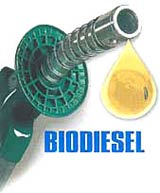
Biodisel
Biodeisel is diesel fuel made from renewable sources of carbon such as used vegetable oil or animal fats used in cooking. In diesel engines it can be used as a direct substitute for petrodiesel fuel made from petroleum.
Biodiesel is a clear amber liquid. Its consistency is similar to that of petrodiesel. Biodiesel can be used on its own in a diesel engine or mixed with petrodiesel. Some people mix small amounts of biodiesel into gasoline to decrease its air-polluting qualities.
Biodiesel is usually made out of the vegetable oil that is most readily available in a particular area. In France most commercial biodiesel is made from rapeseed oil. Other kinds of oil used to make biodiesel include palm, mustard, Jatropha, and soybean.
In the US, soybeans make up the biggest source of biodiesel fuel because they are widely grown. Soybeans are not a particularly good source of biodiesel, but soybean growers have been able to expand the market for soybean-based biodiesel. Rapeseed, mustard, and Jatropha all produce two or three times as much oil as soybeans. Palm oil is an excellent source of oil to make biodiesel, and there has been some research into growing algae to use in making the fuel. Scientists are working on developing crops that produce larger amounts of oil for use in making biodiesel.
Biodiesel users sometimes refer to biodiesel or biodiesel blends by the letter B followed by a number indicating the percentage of biodiesel in the mix. For example, B20 is petrodiesel that contains 20 percent biodiesel. B100 is pure biodiesel.
Vegetable oil into diesel fuel
It is possible to run a diesel vehicle on plain vegetable oil from the grocery store. The first diesel engine ran on straight peanut oil. In diesel engines, however, unprocessed vegetable oil is not very good for the engine because it eventually clogs the filters. In order to keep running the vehicle on vegetable oil, the owner must modify the engine; this is generally true even if the owner mixes the vegetable oil with petrodiesel or kerosene. If the vegetable oil is transformed into biodiesel, however, it becomes so similar to petrodiesel that it can be used in an unmodified diesel engine with no ill effects.
Biodiesel can be made from either new or used vegetable oil or from animal fat. Vegetable oil is the most common feedstock. Waste oil is more difficult to process into biodiesel than virgin oil because it must first be filtered to remove impurities. On the other hand, it is cheaper, often free, and is a good way of recycling a product that otherwise would be thrown away.
How biodiesel is made
Biodiesel is made in a chemical process called transesterification. Transesterification involves joining the fatty acids of the vegetable oil or animal fat into long chains of triglycerides. This process converts the oil into long chains of mono-alkyl esters and glycerin. To transform the fats into biodiesel, a processor mixes an alcohol with a lye catalyst (something which causes a chemical reaction faster or at a different rate than it normally would) and then combines the mixture with warm oil. The most common alcohol used in this process is methanol, or methyl alcohol, but ethanol will work as well. The fatty acids float to the top of the mix and are siphoned off as biodiesel, while the glycerin stays at the bottom of the mixing vessel. The biodiesel must then be washed to remove any contaminants that could damage an engine. The process results in two products -- methyl esters (the chemical name for biodiesel) and glycerine (a valuable by-product usually sold for use in the production of soap).
Present use of biodiesel
Biodiesel will work in any diesel engine, with no modifications necessary. This means it can be used as a substitute for petrodiesel fuel. It can be mixed into petrodiesel to reduce emissions, improve engine performance, and clean engine parts.
Many people make their own biodiesel at home. There are many recipes available, easily found on the Internet. Though biodiesel fans claim that whipping up a weekly batch is no problem, the procedure involves a certain amount of trouble, mess, and danger.
Commercial suppliers have been making biodiesel and selling it to the public for several years. Biodiesel is widely used in Europe and Asia. France is the world's largest producer of biodiesel. All petrodiesel fuel sold in France contains at least 5 percent biodiesel. In Germany over 1,500 filling stations sell biodiesel, which is less expensive than petrodiesel. The European Union, of which France and Germany are members, passed legislation to require all member states to mix biodiesel into their petrodiesel. Public transportation fleets are often the first vehicles to adopt the use of biodiesel or biodiesel-petrodiesel blends as their standard fuel.
Biodiesel is becoming more common in the United States. Several states have passed laws requiring biodiesel to be mixed into diesel fuel. Over 500 commercial fleets use biodiesel. Users include the US Postal Service, the US Marine Corps, NASA, the US Dept. of Agriculture and a number of state departments of transportation, .
Benefits of Biodiesel
Biodiesel has many benefits. It is very easy to substitute for petrodiesel. Employees do not need special training to use it and no equipment needs to be modified. Unlike petrodiesel, biodiesel will not catch fire or explode. It is not poisonous to humans. It is completely biodegradable (capable of being broken down into harmless products). It is environmentally much cleaner than petrodiesel.
In addition, bodiesel is an excellent engine cleaner. It will remove dirt and residue left in a tank and fuel system by petrodiesel. Biodiesel can be added to ultra-low-sulfur petrodiesel to improve its lubricity (ability to reduce friction or rubbing). It makes the diesel fuel flow more smoothly and prevents the accumulation of contaminants within the engine and fuel system.
Biodisel copyright 2011 Digtheheat.com
